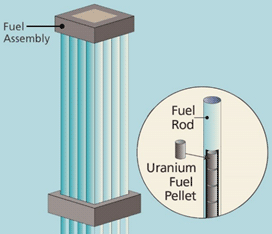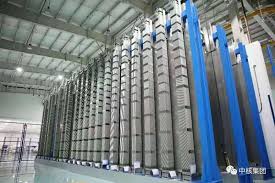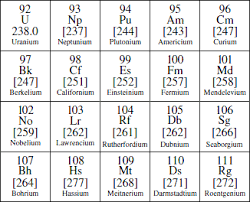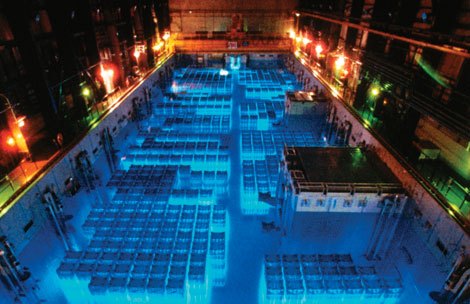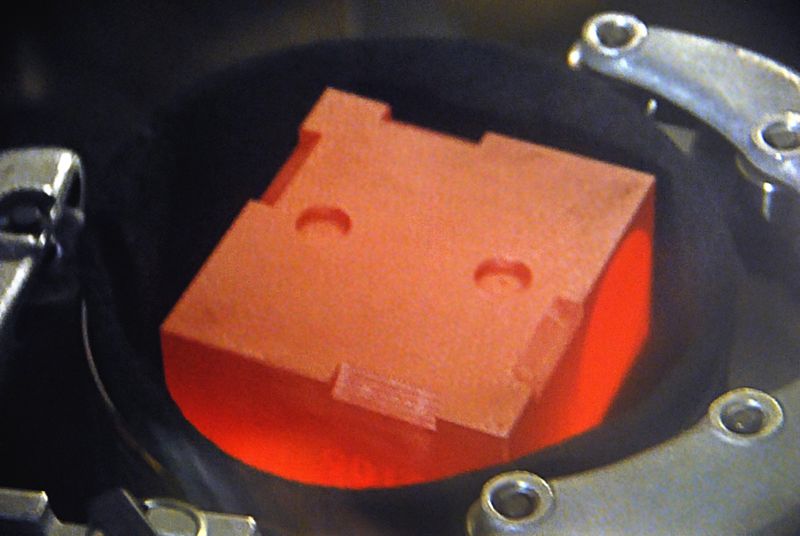Let's talk about nuclear waste, because why the hell not? (Thread 1/18)
(I know I said my next thread would be be about storage, but it's a huge topic that will take much time).
The most important nuclear waste is Spent Nuclear Fuel (SNF).
(I know I said my next thread would be be about storage, but it's a huge topic that will take much time).
The most important nuclear waste is Spent Nuclear Fuel (SNF).
2/18
Simply put, SNF is what comes out of a nuclear reactor using fission to generate heat (that heats water to steam to turn a turbine for power).
When the fuel went into the reactor, it started out as pellets of uranium oxide packed into a long thin clad of zirconium alloy.
Simply put, SNF is what comes out of a nuclear reactor using fission to generate heat (that heats water to steam to turn a turbine for power).
When the fuel went into the reactor, it started out as pellets of uranium oxide packed into a long thin clad of zirconium alloy.
3/18
Those fuel rods are packed together into a bundle called a fuel assembly. Different reactors have different #'s of assemblies. The CNNC-designed Hualong One at Fuqing 5 has 177.. Reactors usually swap about 1/3rd of their fuel assemblies during a fuel reload.
Those fuel rods are packed together into a bundle called a fuel assembly. Different reactors have different #'s of assemblies. The CNNC-designed Hualong One at Fuqing 5 has 177.. Reactors usually swap about 1/3rd of their fuel assemblies during a fuel reload.
4/18
So when those assemblies are removed, this is our 'SNF'. What is it exactly?
Basically it's a chunk of various elements, many of them radioactive. The exact composition changes, because fission yield is random (but on a bimodal curve). This is too nerdy for today.
So when those assemblies are removed, this is our 'SNF'. What is it exactly?
Basically it's a chunk of various elements, many of them radioactive. The exact composition changes, because fission yield is random (but on a bimodal curve). This is too nerdy for today.
5/18
Anyway when the fuel went in, the pellets were made of two isotopes of Uranium: U-235 and U-238. The U-238 is almost inert, but the U-235 is fissile.
Uranium in nature only contains a tiny % of U-235. Enrichment removes U-238 and raises the relative concentration of U-235.
Anyway when the fuel went in, the pellets were made of two isotopes of Uranium: U-235 and U-238. The U-238 is almost inert, but the U-235 is fissile.
Uranium in nature only contains a tiny % of U-235. Enrichment removes U-238 and raises the relative concentration of U-235.
6/18
(Side note: the U-238 removed during enrichment is called 'tails' or 'depleted uranium'. It's very dense but still mildly radioactive, so it has limited uses. The US military used it for ammo, where it had horrible long-term health effects in Iraq). https://theintercept.com/2019/11/25/iraq-children-birth-defects-military/
(Side note: the U-238 removed during enrichment is called 'tails' or 'depleted uranium'. It's very dense but still mildly radioactive, so it has limited uses. The US military used it for ammo, where it had horrible long-term health effects in Iraq). https://theintercept.com/2019/11/25/iraq-children-birth-defects-military/
7/18
Back to the main point. U-235 and U-238 went in, but a nasty cocktail of radioactive materials came out.
Fission products were created by the splitting of U-235 into two smaller elements (while releasing energy). Some of them are very bad, like Sr-90 or Ce-137.
Back to the main point. U-235 and U-238 went in, but a nasty cocktail of radioactive materials came out.
Fission products were created by the splitting of U-235 into two smaller elements (while releasing energy). Some of them are very bad, like Sr-90 or Ce-137.
8/18
Fission products like these are especially dangerous because they are in the 'Goldilocks zone' of high radiation levels AND relatively long half-lives (i.e. they are dangerous to be around AND they take a long time to decay into safe, inert elements).
There's also I-131.
Fission products like these are especially dangerous because they are in the 'Goldilocks zone' of high radiation levels AND relatively long half-lives (i.e. they are dangerous to be around AND they take a long time to decay into safe, inert elements).
There's also I-131.
9/18
Iodine-131 doesn't have a long half life, but is absorbed and stored in the thyroid gland if we are exposed. It causes the metallic air taste reported by many Chernobyl first responders. It also causes thyroid cancer, fortunately very treatable. https://www.thelancet.com/journals/landia/article/PIIS2213-8587(16)30112-7/fulltext
Iodine-131 doesn't have a long half life, but is absorbed and stored in the thyroid gland if we are exposed. It causes the metallic air taste reported by many Chernobyl first responders. It also causes thyroid cancer, fortunately very treatable. https://www.thelancet.com/journals/landia/article/PIIS2213-8587(16)30112-7/fulltext
10/18
Sometimes the U-238 can also pick up free electrons in the fission process. It doesn't split apart. Instead it gets BIGGER, creating a 'transuranic' element, i.e. something BEYOND uranium on the elemental table. Like Neptunium, Plutonium, Neptunium, Curium, etc...
Sometimes the U-238 can also pick up free electrons in the fission process. It doesn't split apart. Instead it gets BIGGER, creating a 'transuranic' element, i.e. something BEYOND uranium on the elemental table. Like Neptunium, Plutonium, Neptunium, Curium, etc...
11/18
Plutonium-239 is a major problematic component of SNF, because it decays with radiation and also has a half-life of 40,000 years.
It only emits alpha particles though, so you'd need to breathe it in to cause health issues. Not as dangerous as beta or gamma particles...
Plutonium-239 is a major problematic component of SNF, because it decays with radiation and also has a half-life of 40,000 years.
It only emits alpha particles though, so you'd need to breathe it in to cause health issues. Not as dangerous as beta or gamma particles...
12/18
SO.
All this stuff is in the waste when it comes out of the reactor. What can we do with it? Basically, we stick it in cold water. This is called the spent fuel pool in a nuke plant. We wait for the most aggressive elements to decay and heat to partly dissipate...
SO.
All this stuff is in the waste when it comes out of the reactor. What can we do with it? Basically, we stick it in cold water. This is called the spent fuel pool in a nuke plant. We wait for the most aggressive elements to decay and heat to partly dissipate...
13/18
Its eventual fate depends on whether your country has policy of open fuel cycle' or 'closed fuel cycle'.
If you have open fuel cycle, you basically don't have a plan. You store it in casks and your gov't fights over where to put it. (e.g. the USA)
https://www.energy.gov/ne/articles/5-fast-facts-about-spent-nuclear-fuel#:~:text=3.,known%20as%20dry%20storage%20casks.
Its eventual fate depends on whether your country has policy of open fuel cycle' or 'closed fuel cycle'.
If you have open fuel cycle, you basically don't have a plan. You store it in casks and your gov't fights over where to put it. (e.g. the USA)
https://www.energy.gov/ne/articles/5-fast-facts-about-spent-nuclear-fuel#:~:text=3.,known%20as%20dry%20storage%20casks.
14/18
If you have 'closed fuel cycle', it means you try to reprocess the waste into something useful. But it's an expensive process to do safely. France does this (for most of EU too). China wants to also.
Some of those fission products are super rare and valuable, after all.
If you have 'closed fuel cycle', it means you try to reprocess the waste into something useful. But it's an expensive process to do safely. France does this (for most of EU too). China wants to also.
Some of those fission products are super rare and valuable, after all.
15/18
For instance Pu-238 is used by NASA as a radioisotope thermoelectric generator (RTG) for deep space. Remember that scene in The Martian where Matt Damon uses it for heat? Yes that's real and accurate!
The USA is out of it, so we buy from Russia.
https://sciencevshollywood.com/staying-warm-with-a-box-of-radiation-on-the-martian/
For instance Pu-238 is used by NASA as a radioisotope thermoelectric generator (RTG) for deep space. Remember that scene in The Martian where Matt Damon uses it for heat? Yes that's real and accurate!
The USA is out of it, so we buy from Russia.
https://sciencevshollywood.com/staying-warm-with-a-box-of-radiation-on-the-martian/
16/18
Various fission products can also used in healthcare (cancer treatment) or have industrial applications.
Any fissile materials could be removed and made into fresh fuel.
New gen reactors can burn almost anything. As can Canadian-designed CANDUs.
https://en.wikipedia.org/wiki/Advanced_CANDU_reactor
Various fission products can also used in healthcare (cancer treatment) or have industrial applications.
Any fissile materials could be removed and made into fresh fuel.
New gen reactors can burn almost anything. As can Canadian-designed CANDUs.
https://en.wikipedia.org/wiki/Advanced_CANDU_reactor
17/18
China has a thriving radioisotope industry which is growing rapidly as many Western countries have moved away from nuclear power and shut down their reactors that were producing a lot of the world's supply, especially Canada. Russia is also big.
China has a thriving radioisotope industry which is growing rapidly as many Western countries have moved away from nuclear power and shut down their reactors that were producing a lot of the world's supply, especially Canada. Russia is also big.
18/18
China is hoping to build a huge reprocessing facility with France, which would be a fuel cycle closeout solution.
The negotiation process has taken ages and very delayed. It took a decade to sign MOU and still no construction. But that's the plan. https://www.reuters.com/article/uk-china-nuclear-idUKKCN1VO1IG
China is hoping to build a huge reprocessing facility with France, which would be a fuel cycle closeout solution.
The negotiation process has taken ages and very delayed. It took a decade to sign MOU and still no construction. But that's the plan. https://www.reuters.com/article/uk-china-nuclear-idUKKCN1VO1IG
19/18
Bonus joke if you read this far:
The most common radioisotope in healthcare is a small device that contains Technetium-99, which slowly decays into Molybdenum-99 to be extracted and used.
This Mo-99 generator in the industry is often called a "moly cow".
I kid you not.
Bonus joke if you read this far:
The most common radioisotope in healthcare is a small device that contains Technetium-99, which slowly decays into Molybdenum-99 to be extracted and used.
This Mo-99 generator in the industry is often called a "moly cow".
I kid you not.

 Read on Twitter
Read on Twitter